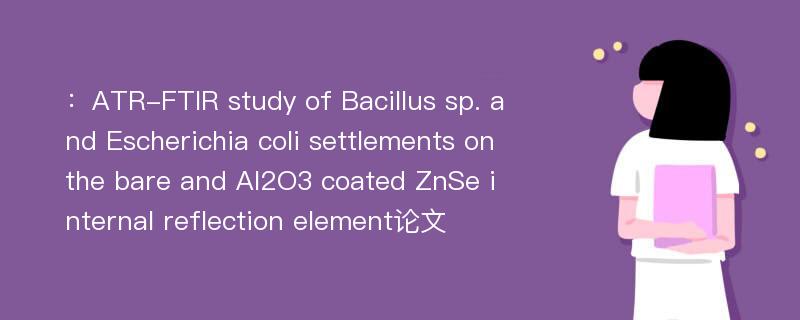
本文主要研究内容
作者(2019)在《ATR-FTIR study of Bacillus sp. and Escherichia coli settlements on the bare and Al2O3 coated ZnSe internal reflection element》一文中研究指出:Marine microorganism accumulated on the surface of ships or pipelines would accelerate fouling organisms, such as mussels and barnacles, adhered on the surface. It was significant to understand the bio-interaction between the microorganisms and the surface. Attenuated total reflection(ATR) Fourier transform infrared(FTIR) spectroscopy was used to study the initial stages of marine microorganism adhering to surfaces, because it could probe the microorganism interaction to the surface regardless of the water interference. Bacillus sp. and Escherichia coli were selected to study the initial attachment on different surfaces, because they were typical fouling microorganisms and showed opposite Gram stain results. The assays were conducted respectively in dried and settled bacteria on two different surfaces(ZnSe, Al2 O3 coated on ZnSe). IR spectra of settled bacteria showed amide I band red shift and amide II band blue shift in aqueous environment on both surfaces compared with the dry bacteria. The reasons of amide bands shift were investigated and it was discovered that the hydrogen bond between the water and the protein of the bacteria led to the protein secondary structure change. ATR-FTIR provided an approach to study the attachment process and showed dynamic changing process on the surface, and it could be an appropriate approach to study the interaction between proteins and chemicals.
Abstract
Marine microorganism accumulated on the surface of ships or pipelines would accelerate fouling organisms, such as mussels and barnacles, adhered on the surface. It was significant to understand the bio-interaction between the microorganisms and the surface. Attenuated total reflection(ATR) Fourier transform infrared(FTIR) spectroscopy was used to study the initial stages of marine microorganism adhering to surfaces, because it could probe the microorganism interaction to the surface regardless of the water interference. Bacillus sp. and Escherichia coli were selected to study the initial attachment on different surfaces, because they were typical fouling microorganisms and showed opposite Gram stain results. The assays were conducted respectively in dried and settled bacteria on two different surfaces(ZnSe, Al2 O3 coated on ZnSe). IR spectra of settled bacteria showed amide I band red shift and amide II band blue shift in aqueous environment on both surfaces compared with the dry bacteria. The reasons of amide bands shift were investigated and it was discovered that the hydrogen bond between the water and the protein of the bacteria led to the protein secondary structure change. ATR-FTIR provided an approach to study the attachment process and showed dynamic changing process on the surface, and it could be an appropriate approach to study the interaction between proteins and chemicals.
论文参考文献
论文详细介绍
论文作者分别是来自Chinese Chemical Letters的,发表于刊物Chinese Chemical Letters2019年01期论文,是一篇关于,Chinese Chemical Letters2019年01期论文的文章。本文可供学术参考使用,各位学者可以免费参考阅读下载,文章观点不代表本站观点,资料来自Chinese Chemical Letters2019年01期论文网站,若本站收录的文献无意侵犯了您的著作版权,请联系我们删除。
